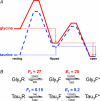What single-channel analysis tells us of the activation mechanism of ligand-gated channels: the case of the glycine receptor
- PMID: 19770192
- PMCID: PMC2821546
- DOI: 10.1113/jphysiol.2009.178525
What single-channel analysis tells us of the activation mechanism of ligand-gated channels: the case of the glycine receptor
Abstract
Glycine receptors are, in several ways, the member of the nicotinic superfamily that is best-suited for single-channel recording. That means that they are ideal for testing ideas about how activation proceeds in a ligand-gated ion channel from the binding of the agonist to the opening of the channel. This review describes the quantitative characterization by single-channel analysis of a novel activation mechanism for the glycine receptor. The favourable properties of the glycine receptor allowed the first detection of a conformation change that follows the binding of the agonist but precedes the opening of the channel. We used the term 'flipping' to describe this pre-opening conformational change. The 'flipped' state has a binding affinity higher than the resting state, but lower than the open state. This increased affinity presumably reflects a structural change near the agonist binding site, possibly the 'capping' of the C-loop. The significance of the 'flip' activation mechanism goes beyond understanding the behaviour and the structure-function relation of glycine channels, as this mechanism can be applied also to other members of the superfamily, such as the muscle nicotinic receptor. The 'flip' mechanism has thrown light on the question of why partial agonists are not efficacious at keeping the channel open, a question that is fundamental to rational drug design. In both muscle nicotinic and glycine receptors, partial agonists are as good as full agonists at opening the channel once flipping has occurred, but are not as effective as full agonists in eliciting this early conformational change.
Figures





References
-
- Adams PR. An analysis of the dose-response curve at voltage-clamped frog-endplates. Pflugers Arch. 1975;360:145–153. - PubMed
Publication types
MeSH terms
Substances
Grants and funding
LinkOut - more resources
Full Text Sources
Molecular Biology Databases

